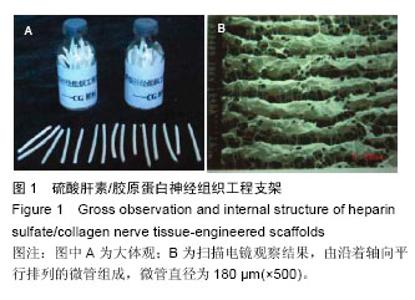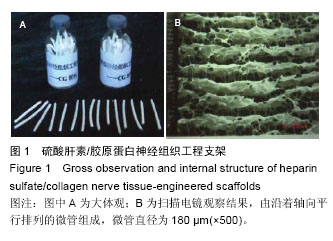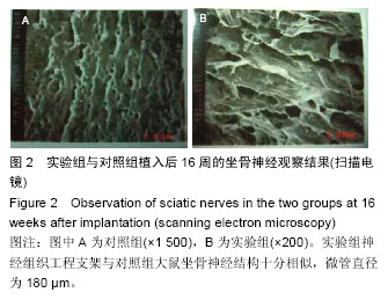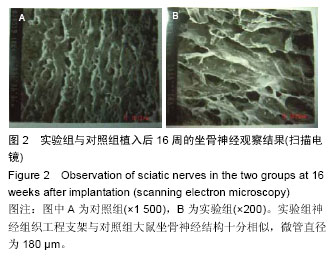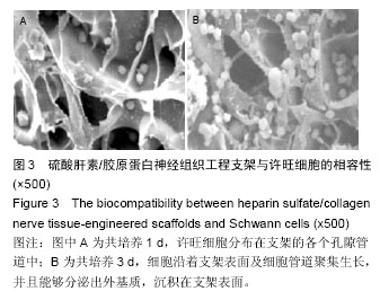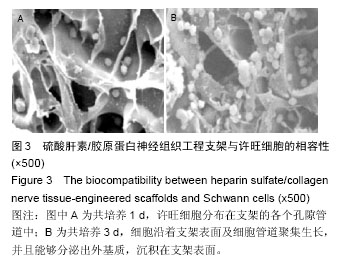| [1] 陆艳,迟放鲁,赵霞,等.丝素导管修复面神经缺损的实验研究[J].中华耳鼻咽喉头颈外科杂志,2006,41(8):603-606.[2] 胡庆柳,朴英杰,邹飞.人发角质蛋白导管修复周围神经缺损的实验研究[J].第一军医大学学报, 2002,22(9):784-787.[3] 严小莉,赵微加,赵亚红,等.Ames实验对丝素蛋白人工神经导管遗传毒性的研究[J].交通医学, 2009,23(5):459-464.[4] 谢峰,李青峰,赵林森,等.几丁糖~聚乳酸复合生物材料神经导管的预构[J].组织工程与重建外科杂志, 2005,2(1): 42-46.[5] 魏海刚,李蜀光,邱雅,等.联合应用神经营养因子和人工神经导管修复兔面神经缺损的实验研究[J].新医学, 2010, 41(5): 307-309.[6] 谢峰,李青峰,顾彬,等.神经导管修复周围神经损伤的临床应用[J].整形再造外科杂志,2004,1(3):144-146.[7] 张凤久,赵志英,刘启,等.神经导管修复大鼠坐骨神经缺损实验研究[J].包头医学院学报,2010,26(3):14-16.[8] 谭学新,马丽,李波,等.丝素-壳聚糖神经导管修复兔面神经缺损的神经电生理变化[J].中国医科大学学报, 2009, 38(4):253-255.[9] 沈华,沈尊理,张佩华,等.壳聚糖神经导管修复犬胫神经缺损的实验研究[J].中国美容医学,2006,15(6):635-637.[10] 赵红斌,马敬,杨银书,等.胶原神经导管贵外周神经缺损修复的实验研究[J].生物医学工程与临床, 2010,14(2):100-104.[11] Wang AJ,Aao Q,He Q,et al.Neural Stem Cell Affinity of Chitosan and Feasibility of ChitosanBased Porous Conduits as Scaffolds for Nerve Tissue Engineering. Qinghua Daxue Xuebao:Ziran Kexue Yingwenban. 2006;11(4):415-420.[12] 顾晓松,胡文.组织工程神经修复周围神经缺损研究及其展望[J].解剖学杂志,2012,35(4): 409-411.[13] Pabari A,Yang SY,Seifalian AM,et al.Modern surgical management of peripheral nerve gap.J Plast Reconstr Aesthet Surg.2010;63(12):1941-1948.[14] Tang X,Xue C,Wang Y,et al.Bridging peripheral nerve defects with a tissue engineered nerve graft composed of an in vitro cultured nerve equivalent and a silk fibroin-based scaffold.Biomaterials. 2012;33(16): 3860-3867.[15] Carriel V,Garrido-Gomez J,Hernandez-Cortes P,et al.Combination of fibrin-agarose hydrogels and adipose-derived mesenchymal stem cells for peripheral nerve regeneration. J Neural Eng. 2013; 10(2):026022.[16] Shen H,Shen ZL,Zhang PH,et al.Ciliaryneurotrophic factor coated polylactic-polyglycolic acid chitosan nerve conduit promotes peripheral nerve regeneration in canine tibial nerve defect repair.J Biomed Mater Res B App1 Biomater.2010;95(1): 161-170.[17] Yang Y,Zhao W,He J,et al.Nerve conduits based on im mobilization of nerve growth factor onto modified chitosan by using genipin as a crosslinking agent.EurJ Pharm Biopharm.2011;79(3):519-525.[18] Barmpitsioti A,Konofaos P,Ignatiadis I,et al.Nerve growth factor combined with an epineural conduit for bridging a short nerve gap(10 ram).A study in rabbits. Microsurgery.2011;31(7):545-550.[19] 张耀丹,王晓明,黄更珍.周围神经损伤修复技术的研究进展[J].中华损伤与修复杂志:电子版,2013,8(2):210-213.[20] Werner MU, Bischoff JM,Rathmell JP,et al.Pulsed radiofrequency in the treatment of persistent prain after inguinal herniotomy: a systematic review. Reg Anesth Pain Med.2012;37(3):340-343.[21] Tos P,battiston B,Ciclamini D,et al. Primary repair of crush nerve injuries by means of biological tubulization with muscle-vein-com-bined grafts.Micrsurgery. 2012; 32(5):358-563.[22] Wang Y,Zhao Z,Ren Z,et al.Recellularized nerve allografts with differentiated mesenchymal stem cells promote peripheral nerve regeneration.Neurosci Lett. 2012;514(1): 96-101.[23] Yang Y,Zhao W,He J,et al.Nerve conduits based on immobilization of nerve growth factor onto modified chitosan by using genipin as a crosslinkingagent.Eur J Pharm Biopharm.2011;79(3):519-525.[24] Godinho MJ,Teh L,Pollett MA,et al. Immunohistochemical,Ultrastructural and Functional Analysis of Axonal Regeneration through Peripheral Nerve Grafts Containing Schwann Cells Expressing BDNF, CNTF or NT3.PLoS One. 2013;8(8):e69987. 1-19.[25] 吴林清,殷超,景尚斐,等.周围神经损伤后修复再生的研究进展[J].中华临床医师杂志:电子版, 2014,8(7):1338-1341.[26] 李强,伍亚民,申屠刚,等.FK506缓蚀剂促进周围神经轴浆输功能恢复的实验研究[J].中国创伤骨科杂志, 2011, 13(10):947-950.[27] 吴兵,郭义柱,王岩,等.化学去细胞同种异体神经移植修复臂丛神经缺损23例[J].军医进修学院学报, 2012,33(11): 1108-1110.[28] 李航旭,皱练,刘德忠,等.化学去细胞同种异体神经移植修复大鼠骶1神经损伤[J].中国组织工程研究与临床康复, 2011,15(31):5735-5738.[29] 曹荣龙,李长宇,张相彤,等.去细胞坐骨神经天然支架的成分分析[J].中国组织工程研究,2012,16(8):1367-1370.[30] 杨润功,衷鸿宾,朱加亮,等.去细胞同种异体神经移植修复周围神经缺损临床安全性研究[J].中华外科杂志, 2012, 50(1):74-76.[31] 冯之静.甲钴胺与前列地尔改善糖尿病周围神经病变患者周围神经传导速度的效果分析[J].实用心脑肺血管病杂志,2013,21(3):101-102.[32] Ren HL,Jiang JM,Chen JT,et al.Risk factors of new symptomatic vertebral compression fractures in osteoporotic patients undergone percutaneous vertebroplasty.Eur Spine J.2015;24(4):750-758.[33] Geoffroy V,Chappard D,Marty C,et al.Strontium ranelate decreases the incidence of new caudal vertebral fractures in a growing mouse model with spontaneous fractures by improving bone microarchitecture. Osteoporos Int. 2011;22(1):289-297.[34] Chen H,Kubo KY. Segmental variations in trabecular bone density and microstructure of the spine in senescence-accelerated mouse(SAMP6): a murine model for senile osteoporosis.Exp Gerontol.2012; 47(4):317-322.[35] Kim DG,Shertok D,Ching TB,et al.Variability of tissue mineral density can determine physiological creep of human vertebral cancellous bone.J Biomech. 2011; 44(9):1660-1665. |
